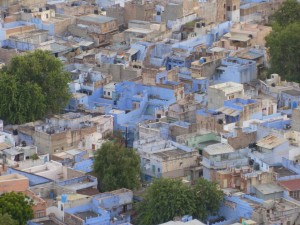The Rajasthan International Folk Festival (RIFF), an annual five-day celebration of folk music and performance traditions from around the globe, just wrapped up this past Sunday in Jodhpur, India. Famous for its royal history and its traditional arts, Rajasthan is a major international travel destination. Tourism means more business for the state, but how do Rajasthan’s artists fare?

During a folk performance in Rajasthan’s Thar Desert a few weeks ago, I found myself pulled from my comfortable cushion at the edge of the stage and made to dance in front of a large, cheering crowd. I soon realized that I was tripping over my feet not to a Rajasthani folk song but to a familiar Bollywood tune played on dholak and harmonium!
Rajasthan abounds with artistic talent and its famed handicraft markets overflow with colorful wares ranging from hand-printed bedspreads to exquisite silverwork. Such abundance and the availability of cheaper, factory-made goods begs the question: How can artists make a living in Rajasthan?
Roughly the size of New Mexico, Rajasthan is a large state in northwestern India with vast stretches of desert. The “Land of Kings,” it consisted of approximately 20 small kingdoms before India’s independence and partition in 1947. This, in part, accounts for the almost overwhelming variety of musicians, dancers, and artists in Rajasthan today.
Meharuddin Langa, a “living legend,” playing the algoza during an RIFF performance.
Outside of Jodhpur, we visited a family of weavers long renowned for the quality of their carpets, and in Jaisalmer we met an uncle-nephew puppet troupe carrying on a five-generations-old tradition. Every artist we met seemed to have a similar story of inherited skills.
Thousands of people from India and abroad visit the state each year looking to experience traditional Rajasthani culture. Palace-themed hotels, camel safaris, and “folk” music and dance performances such as we attended appear to be flourishing. Tourism is unquestionably vital to Rajasthan’s economy, but after a few days of travel I found myself wondering if it benefits everyone in the same way.
Surviving as an artist in Rajasthan is definitely as challenging as it is the world over, and the downside to tourism is that it can reduce artistry to mere “lite fare.” Perhaps the more important question then is: How can Rajasthan sustain its vibrant artistic traditions in a way that both honors the past and helps its artists grow and thrive?
Several visionary individuals and organizations in Rajasthan have already taken up the call to achieve this goal, including encouraging collaboration between Rajasthani and international artists. The Jaipur Virasat Foundation (JVF), a nonprofit trust founded by John and Faith Singh in 2002, is at the forefront of this movement.
“Virasat” means “heritage” in Hindi—a fitting designation for an organization dedicated to promoting Rajathan’s traditional arts as well as to creating new opportunities. The folk festival is one of JVF’s many initiatives, and the trust has conducted searches throughout remote parts of Rajasthan for the state’s most talented artists.
A few years ago, JVF brought UK artists Jason Singh and Bex Mather to Rajasthan to conduct workshops and perform with folk musicians. The result? Dharohar: A sensitive and successful merging of artists from different cultural and social backgrounds who toured and performed together throughout India. During the performances, Singh joined forces with morchang (mouth harp)-player Raies Khan for a jugalbandhi (duet) such as the world has never seen before.
Arrangements for traditional instruments go awry very quickly when sounds and instruments are senselessly thrown together—particularly so in the vague genre of “fusion” music. But Singh and Khan’s musical duo works because it’s an innovatively simple pairing of musical techniques and artists who are perfectly attuned to one another.
Are projects like Dharohar and RIFF sustainable and will they benefit artists in the long run? Optimistically, I would say “yes,” because such types of well-organized performances and recording projects provide Rajasthani artists with access to the growing number of people with globally oriented, non-commercial music interests. And for listeners, it is now easier to discover such music thanks in great part to the internet.
Of course, nonprofit projects are susceptible to the ebb and flow of funding, and there’s also commercially oriented competition in Rajasthan…which brings me back to the subject of tourism. If not specifically visiting to attend RIFF or another festival, what can a tourist possibly do to help Rajasthani artists?
- Take a little time to research before you go. (I write this tongue-in-cheek having attended a Bollywood-themed performance.) Cruise the internet a bit and reach out to a local non-profit organization, which may be able to recommend lesser-known performances and artist collectives. We found a lot of handicraft collectives, both in the city and in the countryside.
- Don’t be afraid to explore and ask around once you’re there. In our case, this led to a private puppet show and a dance performance in the courtyard of a lakeside haveli.
Again, tourism is essential to Rajasthan’s economic vitality and even the commercial ventures provide opportunities for artists. But options do exist that more fully showcase the individuals who are helping to keep the state’s amazing artistic traditions alive, so why not choose one of those instead? You’ll have a more meaningful and memorable experience—and if you aren’t careful, you might also find yourself onstage.
